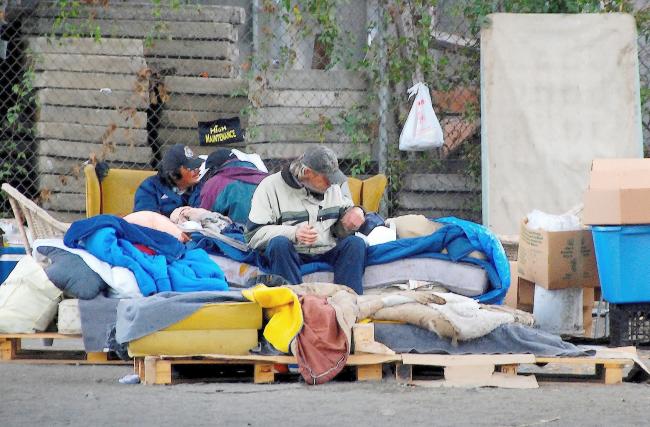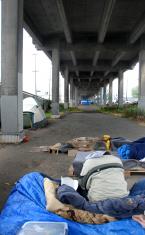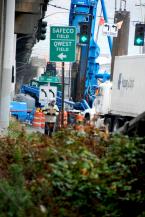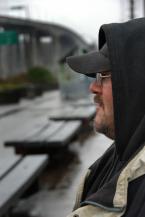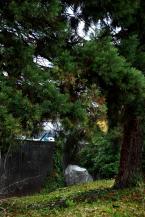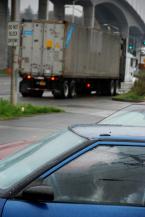Slideshow: Homeless camps sprouting under West Seattle Bridge
One of the new homeless encampments under the West Seattle Bridge, this one just south of the 1st Avenue exit ramp.
Click on the image to see a slideshow.
Sun, 11/01/2009
A homeless camp has emerged with over 20 residents by day, seven by night, tucked under the West Seattle Bridge. If you drive eastbound on the bridge and exit at the 1st Avenue South off-ramp you will see a large tent, several mattresses, foam cushions, and blankets on top of wooden pallets, a few worn couches and chairs, a small barbeque, and food containers.
Some homeless residents take turns holding a cardboard sign soliciting money a couple of hundred feet east of the camp at the stoplight from drivers with whom they manage to make eye contact.
Tucked away, yes, but not so cozy. The chilly fall air seems to blow through the bridge’s cement columns without mercy, and there is the rip-roaring racket of the cars and trucks on the bridge overhead. It is difficult to hear someone’s voice right next to you in their homestead.
“You get used to the noise, but if you’re a light sleeper you’re going to have problems here,” said Al, 47, a camp resident who said his family is Native American Cowichan from Vancouver Island. “All my family members are gone, including my mom and dad. I’ve lost nine members in the last 15 years. They either died naturally or got killed.
“I have a daughter back in California, 26,” said Al. “She’s doing great, 10 years since I saw her. I called her two years ago. Her mom and I aren’t on the best terms. After we split up I decided to come back to Seattle because of family here.
“I used to cut glass, but I messed up and started using,” added Al. “There’s some things I’ve been procrastinating I should have taken care of. It’s just a matter of getting up one day and taking care of my business. It’ll be fine after that. I’ll get back on my feet. I’ll be able to go after work, sleep indoors.”
Another resident, Ali, sat across from Al. Ali said he was born in rural Kenya and fished in Alaska. Another resident, also named Al, was working his shift holding the sign on the corner. Tammy and her black Labrador retriever, camp regulars, would be returning later.
Al said the Seattle Department of Transportation crews busy reconfiguring the bridge’s on and off-ramps have been kind to the homeless there.
“I talked to some of the supervisors at SDOT and this is their property,” said Al. “They don’t mind us here as long as we try to keep it clean. They’ve been real nice to us.
“People actually drop furniture off here,” he continued. “There are some great people out there. There are a couple of church groups who come by and offer us lunches, blankets, and water. But as far as their offers of shelter goes, you’re going to want to have to go to treatment.”
Two other homeless enclaves have sprouted a half mile west of this camp. One is in a small clump of vegetation just east of Harbor Island and the strip of sidewalk where people salmon fish. The other is immediately to its south, where people, like Malcolm, live in their cars, vans, and campers.
“I came to Seattle looking for work,” said Malcolm, 37, who lives in his Geo Prism with Tangi, his dog. His possessions are crammed in the back seat.
“I was in the medical field, an EMT, orthopedic technician, and medical assistant,” he said, adding that he served in the army and was stationed at Fort Lewis.
“The VA was helping me, and told me they’d get me an apartment when I find a job. I apply for jobs, even fast food, every week. I get food stamps, but got to keep gas in the car, buy dog food, and pay for my cell phone in case I get a call back about a job. I’m not the one to be holding the sign up on the corner saying ‘Help me.’ I was raised to work, and not beg for anything. It’s been hard asking people for help.”
If you have a job possibility for Malcolm, please contact him through steves@robinsonnews.com.

